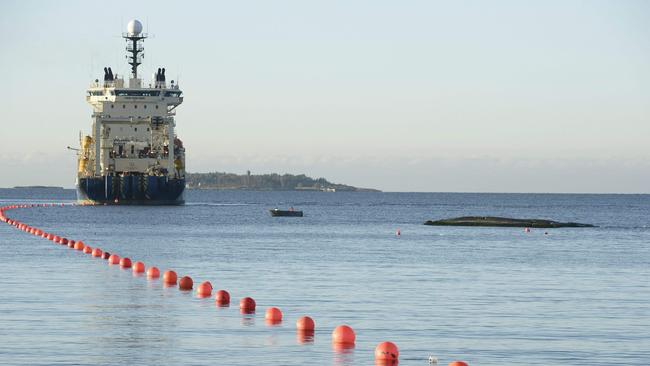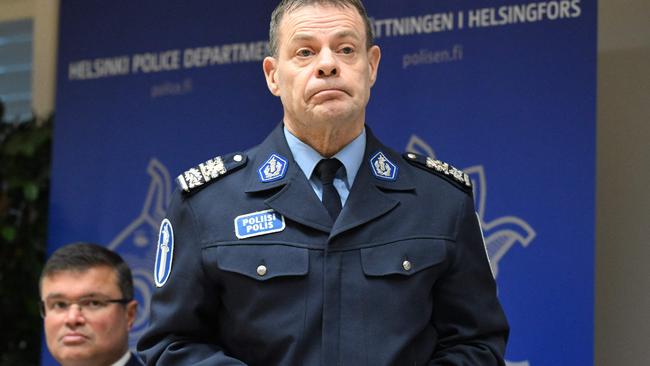Russia tanker detained after more undersea Baltic cables cut
Finland detained the Russia tanker – part of Putin’s ‘dark fleet’ of sanctions busters amid calls for NATO to defend against growing incidents of sabotage blamed on Moscow.

Finland has detained a tanker carrying Russian oil on the suspicion that it had severed undersea power and data cables on Christmas Day, prompting calls for NATO to defend against growing incidents of sabotage against European critical infrastructure blamed on Moscow.
The Eagle S, a tanker that authorities say is part of Russia’s sanctions-busting effort known as the “shadow fleet,” was boarded by Finnish border guard and police after it traversed the cables connecting Finland and Estonia around the time they ceased to function on Wednesday after 12pm, Finnish authorities said. The Eagle S slowed down as it reached Estlink 2 power cable, then lingered above it before continuing its journey, according to the ship-tracking website, Marine Traffic.
Four data cables, three linking Finland and Estonia and one linking Finland and Germany, suffered outages at the same time, Finnish authorities said. One of them, known as C-Lion1, was cut last month in a similar incident involving a Chinese cargo ship. Cinia, the cable owner, said it had dispatched a repair team to fix the cable for the second time in weeks.
The Finnish government and private telecom operators said there was little effect for consumers, as they are able to fall back on reserve cables to avoid data and power disruptions. However, the power cable operator Fingrid said that fixing the 650-megawatt link could take months, and that the country’s power supply could be jeopardised if weather conditions worsen for an extended period.

The Christmas Day cable outages are the latest in a series of incidents involving damage to undersea critical infrastructure belonging to North Atlantic Treaty Organisation countries in the Baltics, a region that has become a flashpoint in a shadow war between Russia and the alliance. The incidents have become common since Vladimir Putin ordered a full-scale invasion of Ukraine in 2022 and up-ended relations with Europe and the U.S.
“We want to take action and put an end to this phenomenon,” Finland’s prime minister, Petteri Orpo, said in a post on X.
Mr Orpo said that he had spoken to other NATO leaders about the incident, and that the issue could be formally raised within the alliance. He said more effort is needed to crack down on the Kremlin’s shadow fleet, because such ships are “pumping money into Russia’s war chest,” allowing it to continue its war against Ukraine.
The governments of both Finland and Estonia held emergency meetings Thursday to discuss the incident. Estonia’s foreign minister, Margus Tsahkna, said the frequency of the incidents means they need to be considered attacks, not accidents.
“In addition to circumventing sanctions, the shadow fleet is a security threat in the Baltic Sea, and we cannot just sit and watch,” Mr Tsahkna said on Thursday.
Immediately after the incident, the Finnish border guard flagship Turva intercepted the tanker, which is registered in the Cook Islands, and accompanied it toward its current location in Finnish waters. Around midnight Thursday, Finnish authorities boarded the ship and assumed command, detaining all crew members on board, said a Finnish police spokesman. At least one of the ship’s anchors was missing, suggesting the cable could have been cut by anchor-dragging along the seabed, the police spokesman said.
Finnish prosecutors have opened an investigation into a possible criminal charge of grave sabotage but wouldn’t comment on whether the incident was accidental or intentional. Finnish authorities established a no-fly zone around the area and will soon investigate the seabed around the damaged cables, a government spokesman said. The Finnish military is assisting, the spokesman said.
Several data cables and a pipeline connecting Finland and other Nordic countries to the European mainland have been severed in the past year in suspected anchor-dragging incidents, but none of the suspect ships have ever been taken over by authorities like in the case of Eagle S.
The high number of similar cable breaks shows that the perpetrators are testing whether cheap civilian ships can cause disruptions of critical infrastructure, said Capt. Jukka Savolainen, a Finnish navy officer and director of the European Center of Excellence for Countering Hybrid Threats, a body established by NATO and the European Union.
Last month, the Chinese bulk carrier Yi Peng 3 cut two data cables, including C-Lion1 that was then damaged again on Christmas Day, by dragging its anchor along the Baltic seabed before being effectively detained in international waters for a month by Danish and German navy and police vessels, according to several people familiar with the investigation. The ship was then allowed to continue after a multination team of investigators led by China boarded it and questioned the crew earlier this month.
International maritime law treats ships in international waters as de facto territory of the country they are registered in, and China only allowed German police to question the crew and gather evidence. Danish, Swedish and Finnish investigators were allowed on board but only as observers, according to people familiar with the probe.
In October last year, another Chinese cargo ship, Newnew Polar Bear, was accused of cutting a data cable and a gas pipeline with its anchor in the Baltic Sea, but authorities at the time failed to stop the vessel, which was transporting goods from one Russian port to another.
The Eagle S tanker that was involved in the latest incident is anchored in Finnish waters, meaning that Finish authorities were able to board the ship and could arrest its crew without the consent of its owner or the country of registration.
The tanker was transporting oil to Port Said in Egypt from the Russian port of Ust-Luga, according to Marine Traffic data. The shipowner, the Caravella LLC Fz, based in the United Arab Emirates, didn’t immediately respond to a request for comment.
The Eagle S, which was built in 2006, has fallen into disrepair, with a number of deficiencies reported during its port calls, according to maritime-data analysts. The shadow fleet’s dilapidated ships are also a threat to the environment, Finnish premier Orpo said.
The Eagle S is part of a tanker fleet shipping sanctioned Russian oil that is owned by an increasingly fragmented and ever-changing web of shell companies and entities in the U.A.E. and India, said Michelle Wiese Bockmann, principal analyst for Lloyd’s List Intelligence, a British maritime-traffic analytics company. The often-dilapidated vessels transport Russian oil under the flag of other nations to circumvent sanctions imposed in response to Moscow’s invasion of Ukraine.
The Eagle S was found to have deficiencies in recent port stops, Bockmann said. “It’s a piece of floating junk steel and compromises environmental and crew safety,” Bockmann said.
The EU said Thursday it would consider new sanctions targeting the shadow fleet following the latest incident.
Dow Jones





To join the conversation, please log in. Don't have an account? Register
Join the conversation, you are commenting as Logout